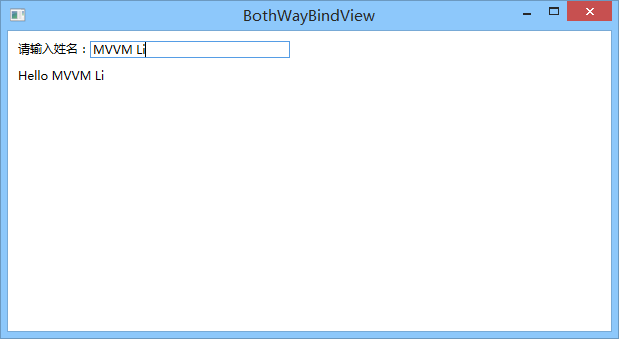MVVMLight怎么实现双向数据绑定
这篇文章主要介绍“MVVMLight怎么实现双向数据绑定”的相关知识,小编通过实际案例向大家展示操作过程,操作方法简单快捷,实用性强,希望这篇“MVVMLight怎么实现双向数据绑定”文章能帮助大家解决问题。
第一步:先写一个Model,里面包含我们需要的数据信息
代码如下:
/// <summary> /// 用户信息 /// </summary> public class UserInfoModel : ObservableObject { private String userName; /// <summary> /// 用户名称 /// </summary> public String UserName { get { return userName; } set { userName = value; RaisePropertyChanged(()=>UserName); } } private Int64 userPhone; /// <summary> /// 用户电话 /// </summary> public Int64 UserPhone { get { return userPhone; } set { userPhone = value; RaisePropertyChanged(() => UserPhone); } } private Int32 userSex; /// <summary> /// 用户性别 /// </summary> public Int32 UserSex { get { return userSex; } set { userSex = value; RaisePropertyChanged(()=>UserSex); } } private String userAdd; /// <summary> /// 用户地址 /// </summary> public String UserAdd { get { return userAdd; } set { userAdd = value; RaisePropertyChanged(() => UserAdd); } }第二步:写一个ViewModel
包含了View所需要的命令和属性:
public class BothWayBindViewModel:ViewModelBase { public BothWayBindViewModel() { UserInfo = new UserInfoModel(); } #region 属性 private UserInfoModel userInfo; /// <summary> /// 用户信息 /// </summary> public UserInfoModel UserInfo { get { return userInfo; } set { userInfo = value; RaisePropertyChanged(() => UserInfo); } } #endregion #region 命令 #endregion }第三步:在ViewModelLocator中注册我们写好的ViewModel:
SimpleIoc.Default.Register<BothWayBindViewModel>();
using GalaSoft.MvvmLight; using GalaSoft.MvvmLight.Ioc; using Microsoft.Practices.ServiceLocation; namespace MVVMLightDemo.ViewModel { /// <summary> /// This class contains static references to all the view models in the /// application and provides an entry point for the bindings. /// </summary> public class ViewModelLocator { /// <summary> /// Initializes a new instance of the ViewModelLocator class. /// </summary> public ViewModelLocator() { ServiceLocator.SetLocatorProvider(() => SimpleIoc.Default); #region Code Example ////if (ViewModelBase.IsInDesignModeStatic) ////{ //// // Create design time view services and models //// SimpleIoc.Default.Register<IDataService, DesignDataService>(); ////} ////else ////{ //// // Create run time view services and models //// SimpleIoc.Default.Register<IDataService, DataService>(); ////} #endregion SimpleIoc.Default.Register<MainViewModel>(); SimpleIoc.Default.Register<WelcomeViewModel>(); SimpleIoc.Default.Register<BothWayBindViewModel>(); } #region 实例化 public MainViewModel Main { get { return ServiceLocator.Current.GetInstance<MainViewModel>(); } } public WelcomeViewModel Welcome { get { return ServiceLocator.Current.GetInstance<WelcomeViewModel>(); } } public BothWayBindViewModel BothWayBind { get { return ServiceLocator.Current.GetInstance<BothWayBindViewModel>(); } } #endregion public static void Cleanup() { // TODO Clear the ViewModels } }第四步:编写View(注意标红的代码)
<Window x:Class="MVVMLightDemo.View.BothWayBindView" xmlns="http://schemas.microsoft.com/winfx/2006/xaml/presentation" xmlns:x="http://schemas.microsoft.com/winfx/2006/xaml" DataContext="{Binding Source={StaticResource Locator},Path=BothWayBind}" Title="BothWayBindView" Height="300" Width="300"> <Grid> <StackPanel Orientation="Vertical" Margin="10,10,0,0"> <StackPanel Orientation="Horizontal" > <TextBlock Text="请输入姓名:" ></TextBlock> <TextBox Text="{Binding UserInfo.UserName,UpdateSourceTrigger=PropertyChanged,Mode=TwoWay}" Width="200" ></TextBox> </StackPanel> <StackPanel Margin="0,10,0,0" Orientation="Horizontal" > <TextBlock Text="Hello " ></TextBlock> <TextBlock Text="{Binding UserInfo.UserName}" ></TextBlock> </StackPanel> <StackPanel HorizontalAlignment="Center" VerticalAlignment="Center" Orientation="Horizontal" > </StackPanel> </StackPanel> </Grid></Window>效果如图所示(当修改输入框的内容的时候,对应绑定数据相应改变,并触发对UI的修改,所以下面那行文字也相应改变改变。):

前面我们已经了解到了,RaisePropertyChanged的作用是当数据源改变的时候,会触发PropertyChanged事件达到通知UI更改的目的(ViewModel => View)。
那View上的变化要怎么通知到数据源呢:
View中文本框绑定内容如下:
{Binding UserInfo.UserName,UpdateSourceTrigger=PropertyChanged,Mode=TwoWay},
大家会看到多了两个属性,一个是UpdateSourceTrigger,一个是Mode属性。
UpdateSourceTrigger的作用是 当做何种改变的时候通知数据源我们做了改变。
| 枚举类型 | 效果 |
| Default | 默认值(默认为LostFocuse) |
| Explicit | 当应用程序调用 UpdateSource 方法时生效 |
| LostFocus | 失去焦点的时候触发 |
| PropertyChanged | 数据属性改变的时候触发 |
这边我们直接使用 PropertyChanged,当UI数据改变的时候,我们再通知到数据源去做修改。
还有一个属性就是Mode,他有五个参数:
| 枚举类型 | 效果 |
| OneWay | 源发生变化,数据就会从源流向目标 |
| OneTime | 绑定会将数据从源发送到目标;但是,仅当启动了应用程序或 DataContext 发生更改时才会如此操作,因此,它不会侦听源中的更改通知。 |
| OneWayToSource | 绑定会将数据从目标发送到源 |
| TwoWay | 绑定会将源数据发送到目标,但如果目标属性的值发生变化,则会将它们发回给源 |
| Default | 绑定的模式根据实际情况来定,如果是可编辑的就是TwoWay,只读的就是OneWay |
这边明显有很多种选择,明确一点的是,我们是想把View上的变化同步到ViewModel(Target => Source),所以使用OneWayToSource、TwoWay、Default或者不写都可以。
严谨点应该使用OneWayToSource。因为是文本框,属于可以编辑控件,所以 Default指向的是TwoWay。
下面还有一个TextBlock,仅仅用于显示的,所以不需要目标对源的修改,无需指定就默认是OneWay,当源改变的时候,会通知它进行修改。
关于“MVVMLight怎么实现双向数据绑定”的内容就介绍到这里了,感谢大家的阅读。如果想了解更多行业相关的知识,可以关注编程网行业资讯频道,小编每天都会为大家更新不同的知识点。
免责声明:
① 本站未注明“稿件来源”的信息均来自网络整理。其文字、图片和音视频稿件的所属权归原作者所有。本站收集整理出于非商业性的教育和科研之目的,并不意味着本站赞同其观点或证实其内容的真实性。仅作为临时的测试数据,供内部测试之用。本站并未授权任何人以任何方式主动获取本站任何信息。
② 本站未注明“稿件来源”的临时测试数据将在测试完成后最终做删除处理。有问题或投稿请发送至: 邮箱/279061341@qq.com QQ/279061341














